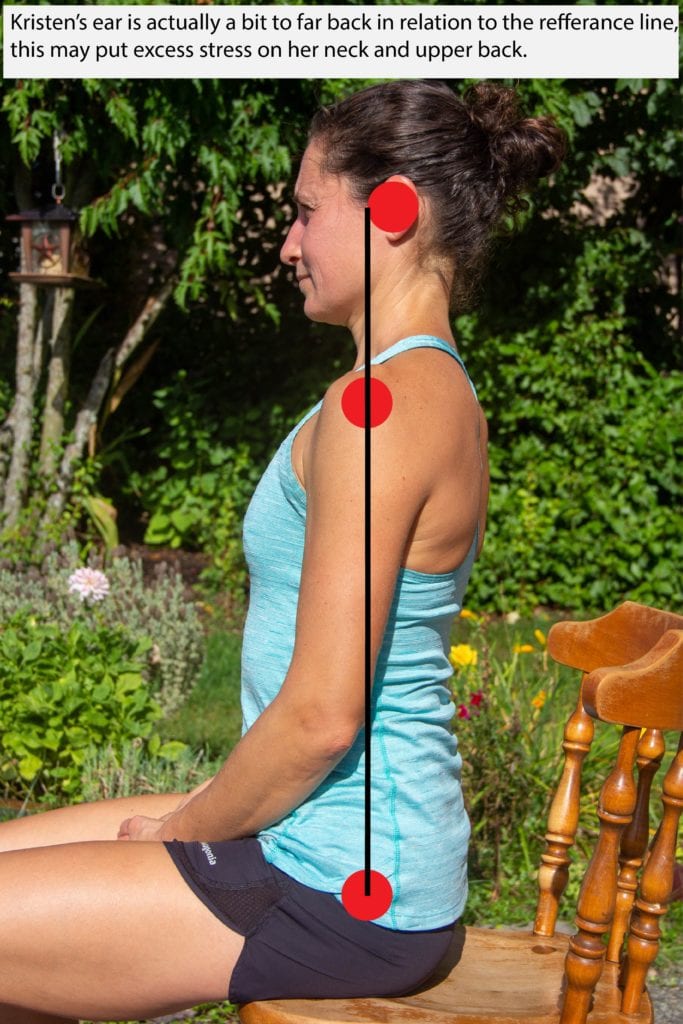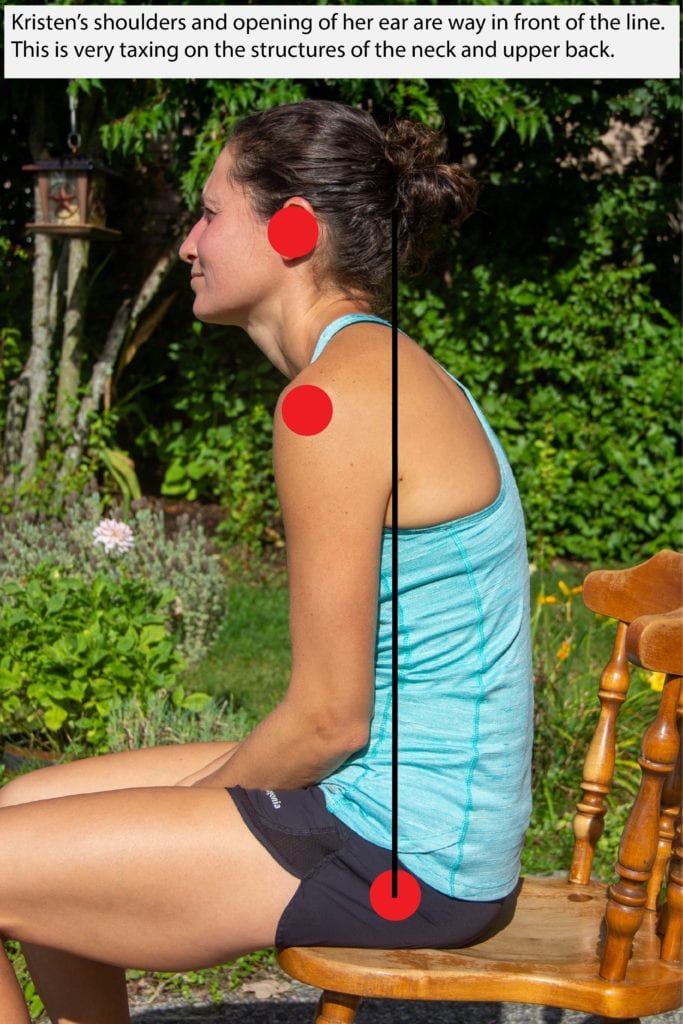Concepts covered:
- What is good posture.
- Why should you care.
- What can you do about fixing it.
We’re going to start this blog off with a lateral thinking puzzle. For those who know me personally, you know that I love a good riddle or puzzle. So here we go…
There was a man found dead in his room, lying on the floor next to a spilled glass of water. How did he die?
Now it’s your turn. You get to ask me yes or no questions until you’re able to solve the situation. Many times you need to think outside of the box in order to solve the scenario. Since a blog does not operate well with two way communication, I will give some commonly asked questions.
- Was the glass of water poisoned? No
- Was he murdered? No
- Was it due to an accident? No
- Did he fall? No, well maybe off his chair but that did not kill him.
On and on the questions could go, but for the astute reader you’re probably wondering if his posture had something to do with it (you know… it’s in the title of the blog). You’re right, his posture did have something to do with it. Also his age and a culmination of bad posture over many years led to such a bad hunch-back that he was no longer able to swallow his glass of water very well anymore without choking on it! So there you have it, he drowned trying to drink a glass of water. Pretty morbid right!
The sad truth is that bad posture can lead to a whole host of medical issues that can lead to major medical issues and even life threatening problems if not put in check. That is why I’m starting off this blog talking about posture. Posture sets up our muscles and joints in the correct positions so that our body can optimally perform under the least amount of stress and strain. Let’s start describing the ideal posture and then in later blog posts we’ll go over a few examples of how it sets your body up for success.
Posture Explained
Perhaps you’ve already found yourself sitting upright a bit more as you read this (if you haven’t… sit up straight). Here are a few bullet points of what good sitting posture should look like.
- Your feet should be flat on the ground and your knees and hips about 90 degrees.
- You should feel like someone is pulling your hair (or hair you wish you had) straight up towards the ceiling.
- This will promote lining up three critical landmarks on your body.
- First, your shoulders should be in line with your hip bones
- Then the opening of your ears should line up with your shoulders.
This may feel like a strain due to any number of muscles and joints structures that have tightened up over time. If it’s difficult to maintain this position for longer than a few moments then it’s already too late and you might as well start putting your last will and testament together… KIDDING (bad joke I know). Actually it’s never too late to start working on correcting your posture and you want to do so before your bones and joint structures change too much.
If you didn’t feel tight or have trouble with finding the right posture, then you can skip to the next blog topic as below we’re going to talk about a few simple stretches that can be done daily to help keep the hunch-back out of your home.
Examples of Good and Bad Posture
Postural Stretch Number One
The chin tuck!
I’m not usually very morbid but yet again I go to a slightly morbid example to help describe this exercise. While trying to attain the posture described above, when it’s time to pull the opening of the ears in line with your shoulders, imagine that your head is resting on a shelf (ewe, I know). You want to slide your head back on the shelf, NOT roll it, in order to line up your external auditory meatus (the opening of your ear) with your shoulders. This will likely feel very tight on the upper portion of the head and neck and possibly down in the lower neck and upper back depending on where your limitations lie.
You’ll want to do repetitions, say 10, every other hour or so throughout the day to slowly help develop improved motion in this direction.
By being able to get your head back in line with your shoulders you’ll be dramatically reducing the stress of the muscles in your lower neck known as the upper trapezius. This will help reduce neck pain and even some postural related headaches.
Cool fact: The average adult head weighs about that of a medium bowling ball (10-15 pounds). When the head starts tipping forward looking down for too long or hunching to look at a computer all day, that’s a lot of extra work for your posterior(back) neck muscles.
Video Demo of Exercise One
Exercise Number Two
Thoracic Extension (upper back) over a Chair
This next exercise addresses the actual hunch-back of the thoracic spine or upper back region. While it’s normal for this part of your spine to curve forward (kyphosis) it can become excessive and the joint structures will tighten up, or worse the bones in the spine can start to wedge and change shape. This exercise will attempt to have you stretch into extension in your thoracic spine.
First things first, find a sturdy chair with a medium height back, maybe a folding chair. Sit in the chair so that the top of the chair-back is positioned along the middle aspect of your shoulder blades. Then clasp your hands behind your neck (interlocking the fingers) and lean back letting the chair-back act as a fulcrum (or pivot point) for the stretch. Perform this one gently up to 10 reps, 2-3 times per day.
Pro tip: you can sit up more in the chair or even slouch a bit to change the fulcrum point on your back and target a new spot. Be gentle with this stretch as it’ll take time (weeks) to get the joint structures to loosen up. Also, do not be surprised if your back cavitates (pops) while doing this. The joints will be happy to start getting some motion back.
Video Demo of Exercise Two
Exercise Number Three
The Pec Stretch
For those who are having trouble getting the shoulders back in line with your hip bones you’ll want to try this one out. It may be due to very tight pectoralis muscles, also known as chest muscles. These muscles can tighten up over time and make it difficult to retract or pull your shoulders back. Try standing in the opening of a doorway and placing your forearms on the sills of the door with your elbows at about the same level as your shoulders. Then slowly and carefully lean into the door while trying to get your shoulders back in line with your hip bones. You’ll want to hold this stretch for 45-60 seconds allowing your muscles to stretch a bit further as you go. This stretch should be done 2-3 times per day to start getting a gain on those tight chest muscles.
Extra credit information: By being able to get your shoulders back in good posture it will improve mobility and circulation into your arms. Tightened pectoralis muscles can lead to compression of a bundle of nerves and vascular structures deep in the shoulder girdle and that can get pretty uncomfortable and lead to a host of medical problems in the upper extremities.
Video Demo of Exercise Number Three
Exercise Handout
We have put together a quick handout with the exercises for your reference. You’ll note there is a URL link and access code if you would like to see a quick video reference of the exercises provided.
Final Thoughts
These are just a few basic exercises that we feel will really help a large number of people put off the detrimental issues associated with poor posture. There are many techniques that physical therapists use to help regain control over your posture. Some include targeted joint mobilization, soft tissue manipulation and additional stretches and exercises to support healthy posture. Please reach out to us today so we can help you create a plan that doesn’t involve letting posture follow you to the grave!
Cheers,
Josh Weaver, DPT
Solid Rock Team


